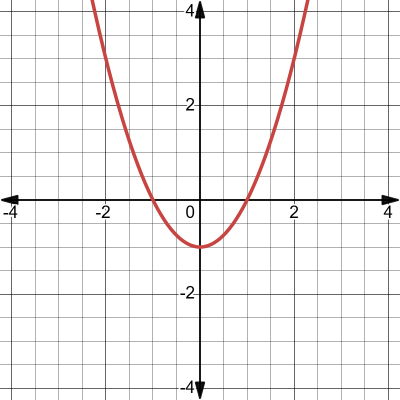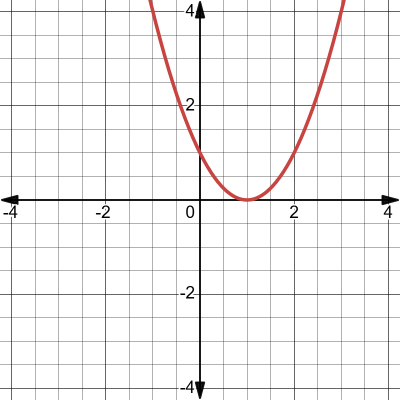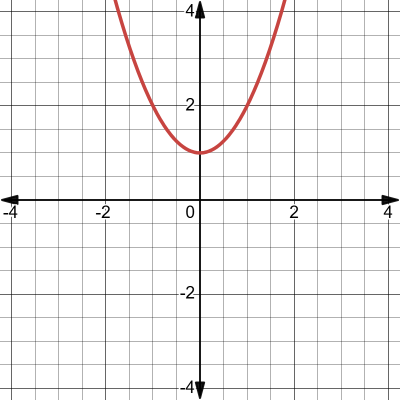4.2. Quadratic and cubic polynomials#
A polynomial of degree \(n\)
has \(n\) roots, which may be real or complex. Real roots may be distinct or repeated. Complex roots always come in conjugate pairs, \(a \pm bi\), where a is called the real part, \(\pm b\) is called the imaginary part, and \(i = \sqrt{-1}\) is the imaginary unit.
4.2.1. Quadratic polynomials#
Quadratic polynomials can have three types of roots:
Two real roots
One (repeated) root
Two complex roots
Graphically, two real roots occur as two intersections of a parabola with the y-axis. For example, the roots of \(x^2 - 1 = 0\) occur at \(x = \pm 1\):

One repeated root occurs as a single point of a parabola (its minimum or maximum) touching the y-axis. For example, the root of \((x-1)^2 = 0\) occurs at \(x = 1\):

Complex roots do not appear as intersections on a graph. For example, the roots of \(x^2 + 1 = 0\) are \(x = \pm i\):

There are several strategies that can be used to find roots of quadratic polynomials:
Factoring
(4.2)#\[\begin{equation} x^2 + 8 x - 9 = (x+9)(x-1) = 0 \end{equation}\]This equation will be true if either factor is zero, so the roots are \(x = -9\) or \(x = 1\).
Completing the square
(4.3)#\[\begin{align} x^2 + 8x &= 9 \\ x^2 + 8x + 16 &= 9 + 16 \\ (x+4)^2 &= 25 \\ x + 4 &= \pm \sqrt{25} x = -4 \pm 5 \end{align}\]This gives the same roots!
Quadratic formula
For the polynomial \(x^2 + 8x - 9 = 0\),
(4.5)#\[\begin{align} x &= \frac{-8 \pm \sqrt{8^2 - 4 \cdot 1 \cdot -9}}{2 \cdot 1} \\ &= \frac{-8 \pm \sqrt{100}}{2} \\ &= -4 \pm 5 \end{align}\]
Example: Box optimization
An open-top box will be made from an 8.5” x 11” piece of paper by cutting out a square from each corner and folding the flaps. What size square should be cut to make the biggest box?
The volume of the box that will be obtained by cutting a square of edge length x is:
The volume will be at an extremum with respect to x if \(V'(x) = 0\):
The roots of this quadratic polynomial are:
Only the first root, 1.59”, is physical because there is not enough material to remove 4.91” from two corners!
Example: Complex roots
Find the roots of
I will use the technique of completing the square:
4.2.2. Cubic (and higher) polynomials#
General formulas for roots of cubic and quartic polynomials are known but complicated. No such formula exists for higher-order polynomials. In these cases, numerical methods are needed!
4.2.3. Skill builder problems#
Solve all roots to 3 significant figures.
\(x^2 + 2x + 1 = 0\), by factoring.
Solution
(4.11)#\[\begin{align} x^2 + 2x + 1 &= 0 \\ (x + 1)^2 &= 0 \\ x &= -1 \end{align}\]\(x^2 - 8x + 5 = 0\), by completing the square.
Solution
(4.12)#\[\begin{align} x^2 - 8x &= -5 \\ x^2 - 8x + 16 &= -5 + 16 \\ (x - 4)^2 &= 11 \\ x &= 4 \pm \sqrt{11} \\ x &\approx 0.683,\, 7.32 \end{align}\]\(x^2 - 7x + 12 = 0\), by quadratic formula.
Solution
(4.13)#\[\begin{align} x &= \frac{7 \pm \sqrt{(-7)^2 - 4 \cdot 2 \cdot 12}}{2 \cdot 2} \\ x &= \frac{7 \pm \sqrt{49 - 96}}{4} \\ x &= \frac{7 \pm \sqrt{-47}}{4} \\ x &= \frac{7}{4} \pm \frac{\sqrt{47}}{4}i \\ x &\approx 1.75 \pm 1.71i \end{align}\]